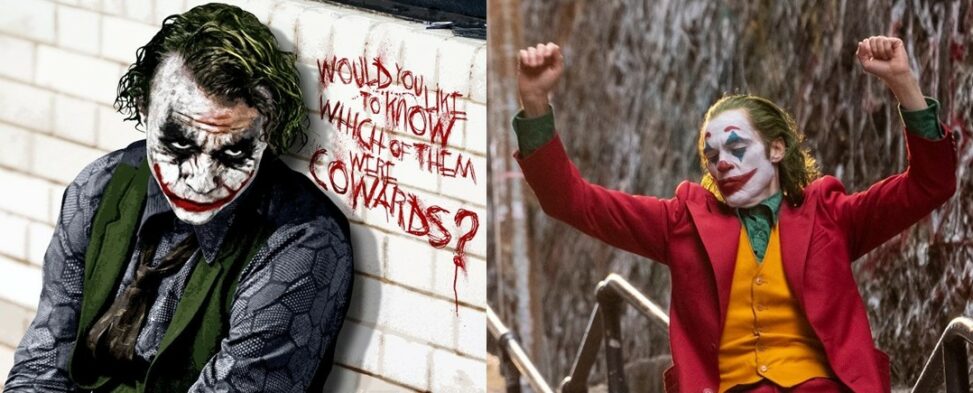The Joker is a potent illustration of how media characters may transform from marginalized, clichéd villains to multifaceted, multifaceted antiheroes, illustrating changing cultural views on power, mental health, and social misfits. The portrayals of the Joker in Todd Phillips’ Joker (2019), starring Joaquin Phoenix, and Christopher Nolan’s The Dark Knight (2008), played by Heath Ledger, are examined in this research. In addition to the psychological and social demands imposed on audiences, each rendition reflects cultural changes in how society views morality, psychiatric illnesses, and the disenfranchised.
The Joker is a statement on personal isolation and social breakdown in both The Dark Knight and The Joker. Phoenix’s Joker, Arthur Fleck, has a socioeconomic and psychological background that explains his spiral into madness, whereas Ledger’s Joker is a mysterious antagonist with little known history. By challenging social conventions and bringing attention to the unhappiness of individuals disadvantaged by socioeconomic circumstances, the Joker’s persona represents an anti-establishment mood (Scarf et al. 2020). Viewers may see the Joker’s transformation from a one-dimensional stereotype to a symbol of societal critique and alienation by juxtaposing him as an antihero in Joker with a villain in The Dark Knight.
Although it has various connotations in each incarnation, the Joker’s masculinity is fundamental to how he is portrayed. According to Brown (2021), Ledger’s Joker is an example of a hyper-masculine character who uses chaos and violence to establish dominance over Gotham and instill terror. This portrayal presents a stereotyped villain who is unmotivated by personal reasons, which is consistent with classic representations of masculine villains who rebel against authority by anarchistic actions. The Joker from Phoenix, on the other hand, embraces a more fragile brand of masculinity that is based on emotional expressiveness and a sensitivity to social rejection. Arthur Fleck’s persona is made more fragile by his mental health issues and his status as a failing comic; this deviates from invulnerability and highlights the complexity of masculine vulnerability and mental illness (Brown 2021).
A significant change between the two depictions is the departure from the cliché of the “insane villain.” Despite being unquestionably sociopathic, Ledger’s Joker has no psychiatric history and is what Skryabin (2021) refers to as “chaos incarnate.” Because this Joker was meant to be feared, it reinforced the stereotype that mental instability precedes violence. However, Phoenix’s Joker offers a compassionate examination of mental illness; Arthur Fleck is shown as a victim of societal failings due to his issues with mental health, economic difficulty, and social isolation. By moving the subject from the edge of insanity to the core of empathy, this representation challenges viewers’ preconceived notions about mental health and class conflict (Scarf et al. 2020).
The Joker’s change in persona has affected how people with mental health disorders are expected to behave in the real world. Despite being universally appreciated for its intricacy, Ledger’s Joker perpetuates the dread of those with mental health issues by reinforcing the relationship between mental instability and violence and unpredictability. However, Phoenix’s Joker dispels these myths by examining the effects of social neglect. By highlighting the structural causes of mental health problems, this representation fosters empathy and promotes conversation about the significance of mental health care (Camp et al. 2010). As a result, the audience is not only captivated by a tale of personal hardship but is also prompted to consider their place in a society that frequently disregards its most vulnerable members.
The Joker’s metamorphosis from a clichéd antagonist to a multifaceted, relatable character has conflicting psychological consequences on viewers. On the one hand, Phoenix’s Joker promotes empathy and compassion by bringing attention to mental health concerns. However, there is a chance that his spiral into violence may be romanticized as a natural response to social exclusion. Audiences may identify with damaging acts as legitimate reactions to social neglect, which might result in a troubling narrative (Scarf et al. 2020). According to researchers like Brown (2021), these depictions may make it difficult to distinguish between empathy and rationalization, which might normalize unhealthy coping strategies used in the face of hardship.
The growth of the Joker has not been without criticism from society. Some critics claim that Phoenix’s Joker risks glorifying the “lone male avenger” character, which might lead downtrodden people to use violence to establish their value. Joker’s debut spurred discussions on how movies might encourage imitation, especially among people who feel excluded and ignored. Others, however, see this representation as a force for change and call for greater resources and understanding of social support networks and mental health. As a result, the Joker is a two-edged criticism that challenges viewers to face society flaws while carefully weighing the hazards of its effects.
It is clear from contrasting The Joker of The Dark Knight with The Joker that the character’s transformation from a representation of unbridled anarchy to a critique of society’s shortcomings reflects shifting cultural perspectives. While Phoenix’s Joker explores the social reasons of estrangement and encourages viewers to identify with the character’s hardships, Ledger’s Joker perpetuates the fear of the unknown and the stereotype of the insane villain. The Joker’s transition from the periphery to the center is highlighted by this change in the character’s representation, which reflects a more sophisticated comprehension of intricate socio-psychological problems. The Joker continues to be a potent prism through which viewers may consider both individual and group responsibility as society struggles with issues of mental health and socioeconomic inequality.
References:
Brown, J. (2021). A city without a hero: Joker and rethinking hegemony. New Review of Film and Television Studies, 19, 7-18.
Camp, M. E., C. R. Webster, T. R. Coverdale, J. H. Coverdale, and R. Nairn. 2010. “The Joker: A Dark Night for Depictions of Mental Illness.” Academic Psychiatry 34 (2): 145–49. https://doi.org/10.1176/appi.ap.34.2.145.
Skryabin, Valentin Yurievich. 2021. “Analysing Joker: An Attempt to Establish Diagnosis for a Film Icon.” BJPsych Bulletin 45 (6): 1–4. https://doi.org/10.1192/bjb.2020.146.
Scarf, Damian, Hannah Zimmerman, Taylor Winter, Hannah Boden, Sarah Graham, Benjamin C. Riordan, and John A. Hunter. 2020. “Association of Viewing the Films Joker or Terminator: Dark Fate with Prejudice toward Individuals with Mental Illness.” JAMA Network Open 3 (4): e203423. https://doi.org/10.1001/jamanetworkopen.2020.3423.


Madison P
With a focus on cultural changes related to mental health, masculinity, and social alienation, this SPLOT submission: From Margins to Centre: Comparative analysis of the Joker in The Dark Knight and Joker offers a sophisticated examination of the Joker’s evolution from a chaotic villain a complex antihero. They effectively discuss the parallels and discrepancies between Joaquin Phoenix’s Joker in Joker and Heath Ledger’s Joker in The Dark Knight, highlighting in particular how their motivations, backgrounds, and depictions of mental health differ. The analysis emphasizes how Phoenix’s Arthur Fleck is shown as a weak, sympathetic figure molded by social neglect, whereas Ledger’s Joker represents disorder and hyper masculinity, acting as a terrifying figure. The key ideas are well stated and discuss how different cultural perspectives on mental illness and masculinity are reflected in each Joker iteration. They add depth to their argument by effectively citing academic literature such as Brown (2021) on representation of masculinity and Scarf et al (2020) on public attitudes of mental illness. The idea of changing depictions of villainy and the social consequence of mental illness is well supported by these sources. Addressing how these representations might affect viewers differently depending on their personal experiences with mental health or social rejection, however, could bolster the criticism. Furthermore, as the article mostly depends on textual analysis without thoroughly examining how the visuals reflect these thematic elements, a more thorough visual analysis of each image could support the character comparison. Overall, the entry effectively considers the cultural development of the Joker and offers perspective comments on the social ramifications of each portrayal using the photos and research.